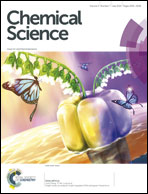Hydrogen abstraction from organotin di- and trihydrides by N-heterocyclic carbenes: a new method for the preparation of NHC adducts to tin(ii) species and observation of an isomer of a hexastannabenzene derivative [R6Sn6]†
Abstract
N-Heterocyclic carbenes are shown to cleanly abstract dihydrogen from organotin di- and trihydrides to intermediately form the reactive stannylene species [R2Sn] and [R′SnH], respectively, as well as the corresponding dihydro imidazole [R = Ph, trip: 2,4,6-triisopropylphenyl; R′ = trip, Ar*: 2,6-bis(2′,4′,6′-triisopropylphenyl)phenyl]. Depending on the molar ratio of the carbene, these intermediates undergo further reactions to form tetraorgano distannanes and carbene adducts in excellent yields. Since the side products can be removed as volatiles, the method offers a facile, clean and high yielding route to stannylene derivatives with strongly decreased steric protection compared to previously known compounds. On stoichiometric reaction hydrogen was completely removed from an organotin trihydride and a novel tin cluster with overall composition R6Sn6 (R = trip) was structurally characterized.
![Graphical abstract: Hydrogen abstraction from organotin di- and trihydrides by N-heterocyclic carbenes: a new method for the preparation of NHC adducts to tin(ii) species and observation of an isomer of a hexastannabenzene derivative [R6Sn6]](/en/Image/Get?imageInfo.ImageType=GA&imageInfo.ImageIdentifier.ManuscriptID=C4SC00365A&imageInfo.ImageIdentifier.Year=2014)

 Please wait while we load your content...
Please wait while we load your content...